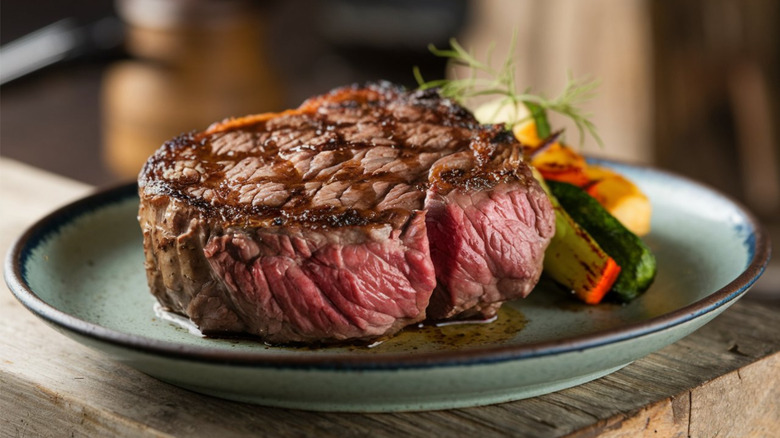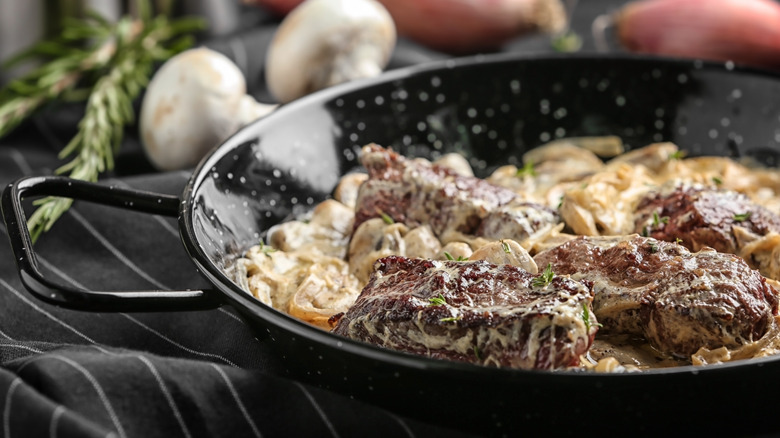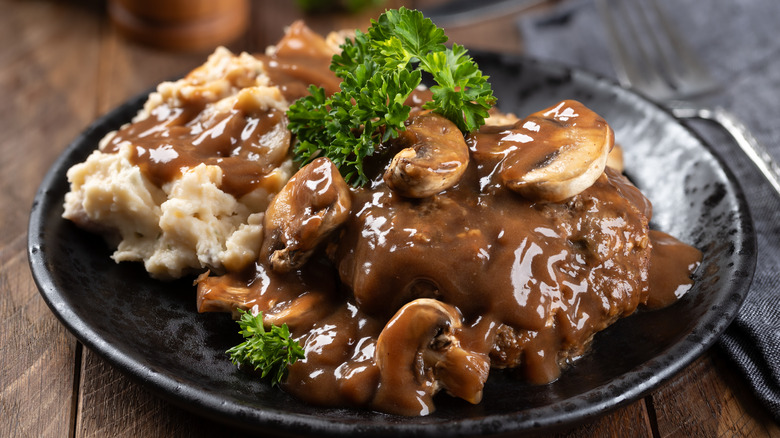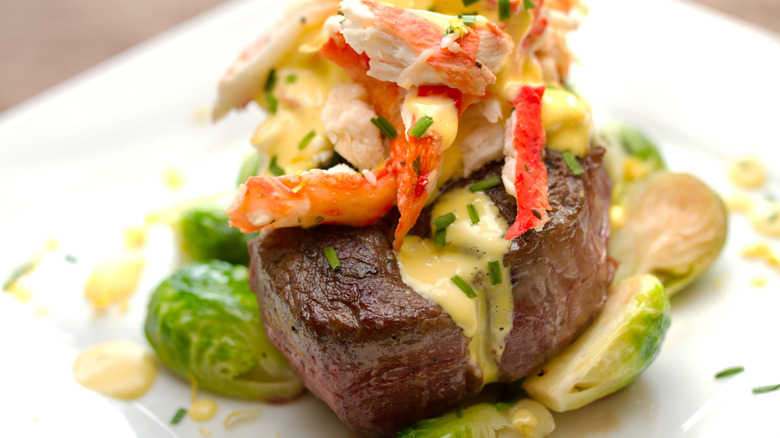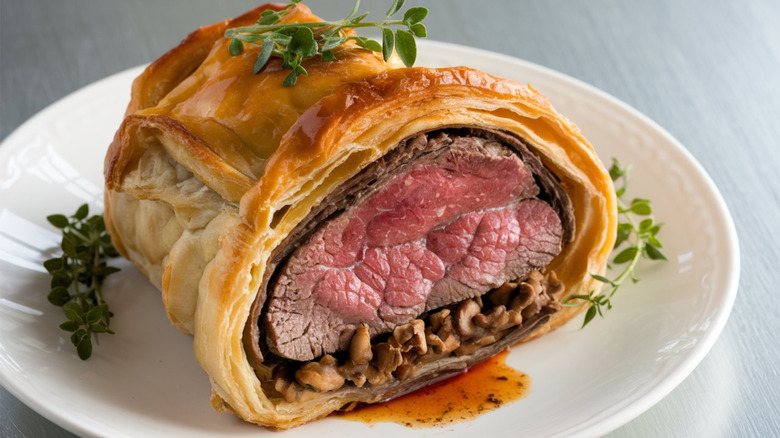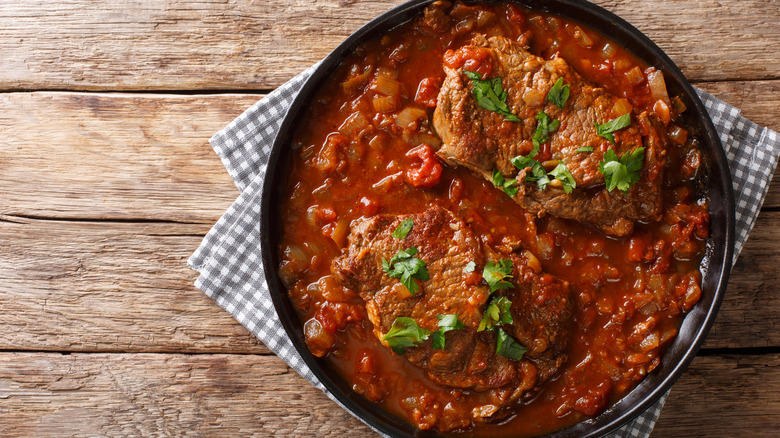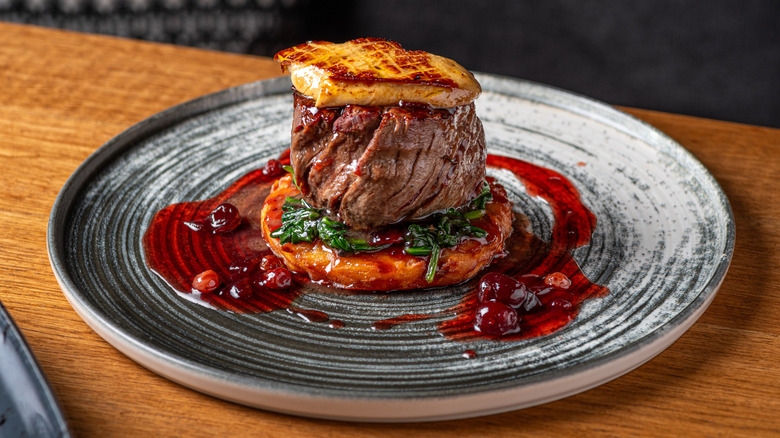7 Once-Popular Steak Dishes That Faded From Restaurant Menus
The steak dinner is the symbol of a truly extravagant, luxurious meal. It's as much about status as it is about flavor, which is probably why it features in so many bachelor party plans. Yet few can deny that a prime cut of porterhouse steak, topped with herb butter and served with a side of loaded baked potato, is a one-way ticket to happiness for so many people just because it tastes that amazing.
And yet, not all steak dishes are created equal, and no restaurant menu remains fixed forever. Years come and go, and what's in culinary vogue changes just as rapidly, if not faster. Some steak dishes rise to the heights of popular taste only to vanish into obscurity or, in some cases, ridicule. What happened to these once-adored beefy beauties? How did so many once-popular steak dishes fall out of mass favor, and could any of them return to the spotlight?
Steak Diane
Once upon a time, steak Diane was the toast of the town. In the mid-20th century up until the 1970s and 1980s, steak Diane became synonymous with high-class dining, particularly in New York City, where it was spectacularly prepared tableside with a flambé.
It's fairly easy to see why, besides even the spectacle of the flambé. Steak Diane is an elegant dish with a long history and roots in French cooking. The name, which comes from the Roman goddess of the hunt, Diana, actually refers to the thick, peppery, cream-infused pan sauce designed to balance the gaminess of venison. Over time, the meat transitioned to tenderloin cuts or filet mignon for added luxury. The combination of theatricality and flavor made steak Diane a mainstay on restaurant menus.
It wasn't one thing that caused this once-popular dish to virtually vanish from the culinary scene; instead, steak Diane fell victim to changing tastes on multiple fronts. Starting in the 1970s, customers started seeking healthier food options, which a steak smothered in a thick cream sauce couldn't deliver. Additionally, restaurants started to emphasize fitting more tables into their floor space, which made tableside service far less feasible or attractive. Finally, the color palette of steak Diane is not exactly the most pleasing, which makes it a tough sell with the modern era's emphasis on food appearance.
Salisbury steak
Does Salisbury steak count as a steak? It's certainly called one, but that feels like semantics. In all honesty, it's more like a hamburger patty without a bun.
To make a Salisbury steak, you form ground beef and some seasonings and breadcrumbs into a vaguely steak-shaped patty. Then you pan-fry it and smother it with gravy. It's similar in some ways to steak Diane, but with ground beef rather than an actual cut. Surprisingly, Salisbury steak actually predates steak Diane, tracing its history to a health food created during the American Civil War to ensure soldiers got their protein.
Salisbury steak's downfall surprisingly came from its own popularity. It was so ubiquitous as a staple dinner, people began to offer it in school cafeterias and as a frozen TV dinner (the form in which it is most known today). Overexposure and low-quality offerings caused it to disappear from the scene, although you can sometimes still find the now-retro dish in the freezer section of your local grocery.
London broil
Technically, London broil is not a distinct cut of steak. At least, it isn't anymore. It did exist as an informal butcher's shop term for an inexpensive cut of beef, most likely flank steak. Nowadays, the term lives on as a method of steak preparation. For many years, though, London broil was considered the way to transform extra-tough cuts of meat into gourmet-level meals.
Usually applied to very thick cuts like top rounds or the above-mentioned flank steaks, London broils involve an acidic marinade with a fat like olive oil and seasonings and at least six hours of sitting. The acid, usually some kind of vinegar, is what makes the difference. It breaks down the tough muscle fibers and softens them considerably. Despite the name, London broils are rarely broiled any more and more commonly get the grill treatment. Also, just to confuse matters further, they're American and not British.
London broils struggle against the tide of both perception issues and supply problems. Transforming less-than-prime steaks caused the London broil to be seen as less than classy. Moreover, the cut that made it so popular at home and at restaurants, the flank steak, has had a cultural revival since it's a key ingredient in fajitas and steak sandwiches. Naturally, prices went up and the once-popular preparation has been left by the wayside.
Steak Oscar
Some steaks disappeared from steakhouse menus because they were perceived as too low-class. Steak Oscar doesn't have the problem. It has the precise opposite problem: it's seen as far too indulgent.
Steak Oscar is essentially a surf-and-turf that has undergone the royal treatment. That's not hyperbole either; King Oscar II of Sweden received the first recorded serving of this dish in 1897. It features filet mignon piled high with crabmeat, Hollandaise sauce, and white asparagus. Every component of this dish is, appropriately enough, kingly. Even the white asparagus is a luxury item that is very tricky to grow.
Steak Oscar once ruled the restaurant scene, but you'd be hard-pressed to find the once-popular dish nowadays. Partly, the health-consciousness craze of the 1980s spelled doom for a steak slathered in a thick buttery sauce. Additionally, the cost started turning customers off; even if you replace the white asparagus with regular green spears, it's still a filet covered in crab meat. Hard to make that inexpensive.
Beef Wellington
To say beef Wellington has defenders would be an understatement. It's considered a prestigious national heritage dish in its native Great Britain. No less a culinary figure than Gordon Ramsay loves the puff pastry-wrapped beef fillet and features it prominently on his restaurants' menus. Yet, at the same time, good luck if you go seeking it here in the United States.
For a while, beef Wellington had huge appeal in the States. Julia Child helped popularize it and made it a fixture of the 1950s and 1960s culinary scene. Presidents John F. Kennedy and Richard Nixon both loved it and served it at the White House. But as the decades passed, America started to lose interest. Partly, the problem lies in its difficulty. Chefs on this side of the Atlantic consider the dish finicky, time-consuming, and very unforgiving, and it's hard to serve en masse in a restaurant setting as a result. It also leans towards the pricey side of the menu, although the enterprising home chef can make some substitutions to make it more affordable.
Swiss steak
So many once-popular steak dishes have misleading names, and Swiss steak is no exception. It has virtually nothing to do with the Alpine country that is its supposed namesake. In fact, the name refers to how the steak is tenderized. Swiss steak takes one of the less expensive and tougher cuts of beef, like eye round or chuck, and beats it with the spiky end of a meat mallet or with a bladed hand tenderizer. Alternatively, you can run the meat through a crank-powered machine that cuts the meat shallowly. The idea overall is to shorten and soften the meat fibers by literally cutting them down to size while simultaneously flattening the meat so it cooks evenly.
Afterwards, the Swiss steak is traditionally braised in a seasoned tomato sauce, softening it even more and imparting an extra-rich flavor. Often served over mashed potatoes, it's no wonder Swiss steak was so beloved back in the day. However, it has virtually vanished from the restaurant scene and isn't a common meal in modern homes. The bias against tougher cuts of beef has sidelined the Swiss steak, as has the dreaded cafeteria food treatment.
Tournedos Rossini
This dish isn't just a steak dish. For a good chunk of time, it was considered the steak dish, the apex of all steak dishes. Even the name alone, Tournedos Rossini, evokes something old-world and borderline mythical. Named for musician, composer, and food lover Gioacchino Rossini and created by a close chef friend, Tournedos Rossini is the ultimate in beef indulgence: filet mignon, Madeira sauce, toast, and a slice of foie gras. Some restaurants even served it with truffles, because why not at that point?
For a long time, every reputable steakhouse in the country served Tournedos Rossini. Now, you'll be lucky to find it anywhere in the United States. Price is perhaps the biggest obstacle: truffles by themselves can bump the price to above $100, and foie gras isn't cheap either. Moreover, foie gras has a very sinister reputation in the States due to the alleged animal cruelty involved in producing it (severely force-feeding geese). The once-popular king of all steaks is unlikely to be mounting a comeback anytime soon.

